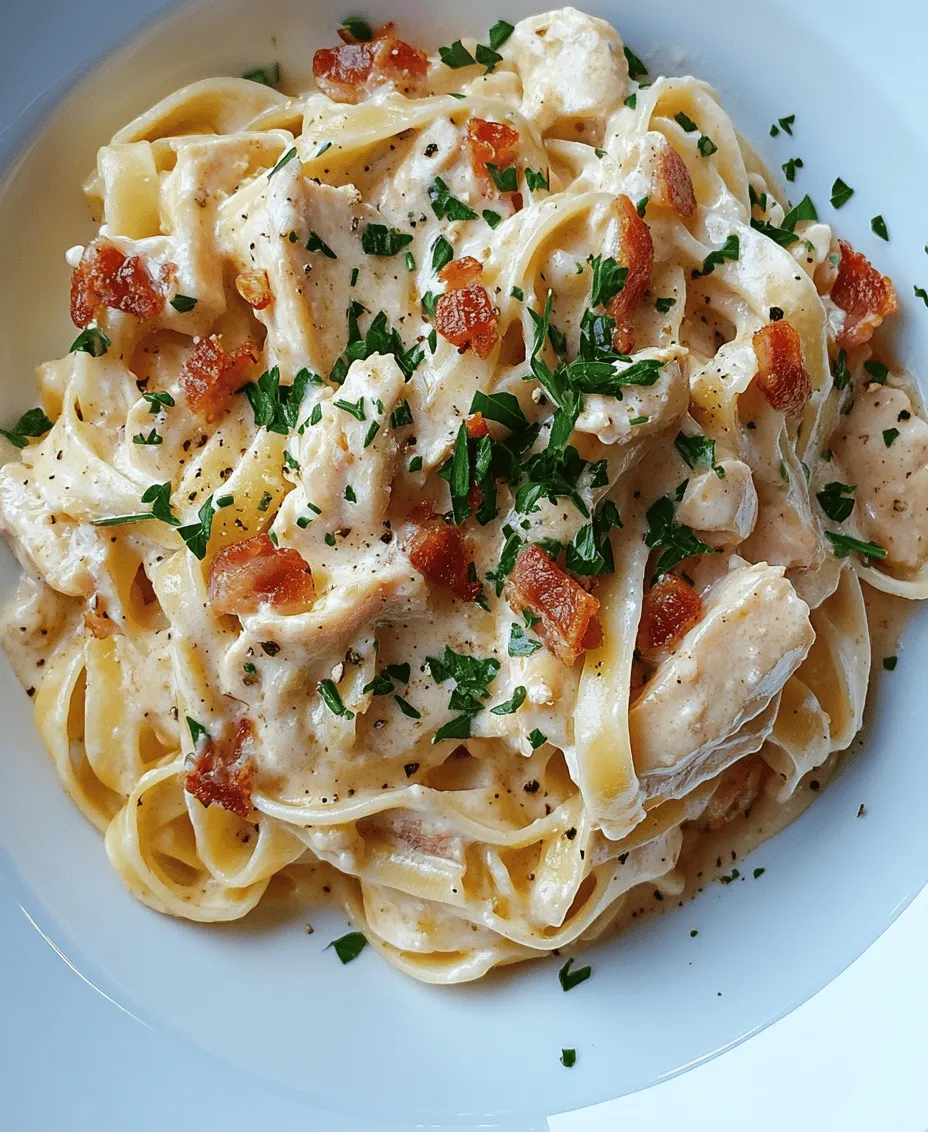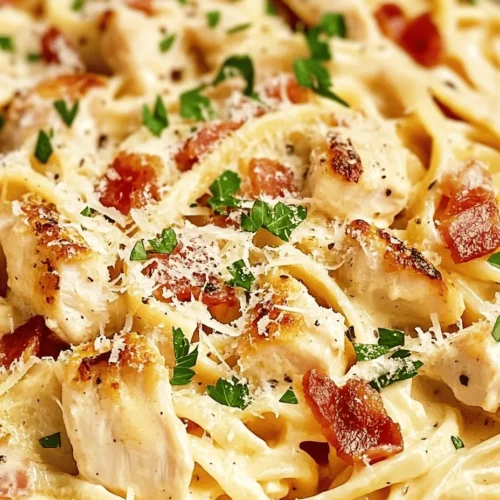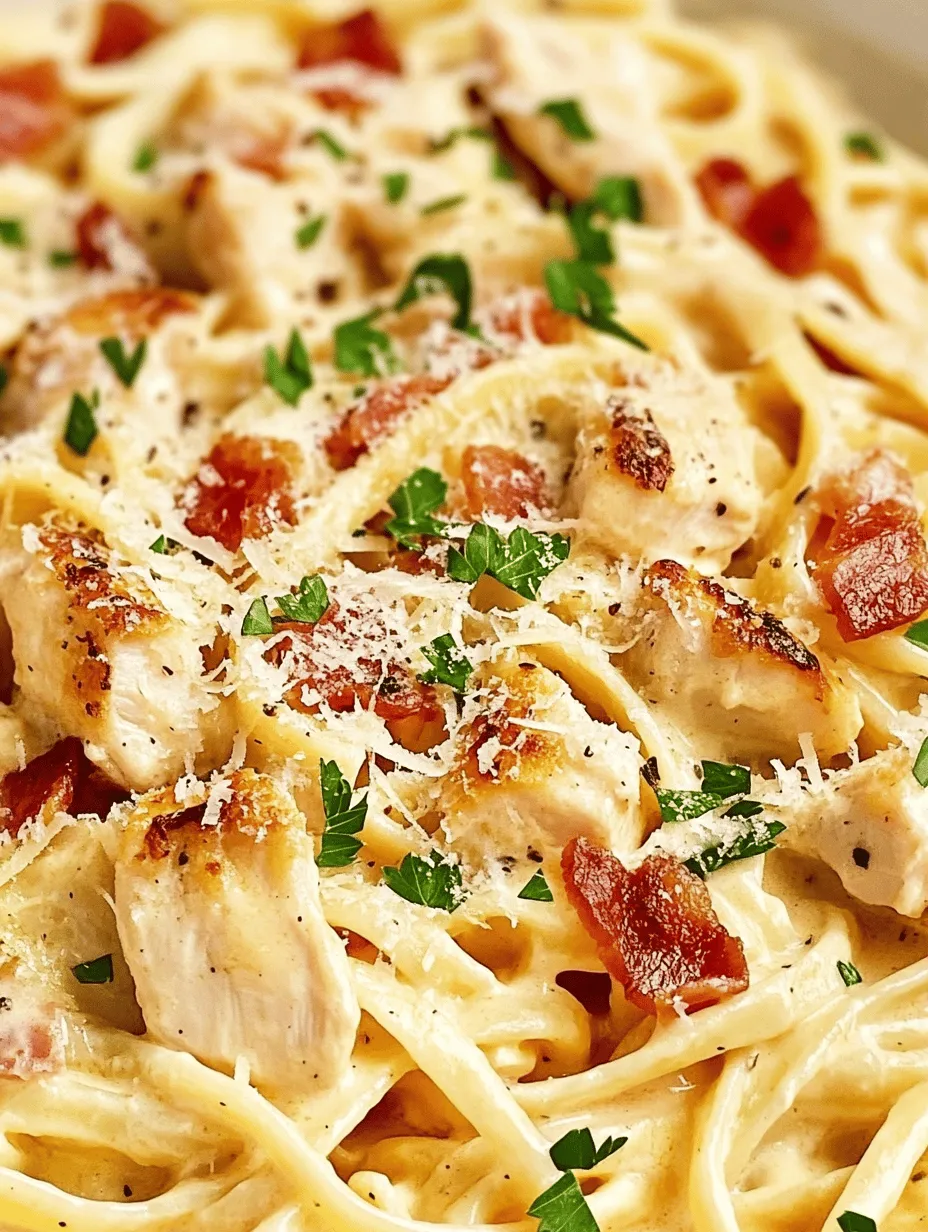Introduction
Chicken Carbonara is a classic Italian dish that has captured the hearts and palates of food lovers around the globe. Known for its creamy texture and rich flavors, this comforting pasta dish is a staple in many households. Originating from Rome, traditional Carbonara is typically made with guanciale, eggs, and Pecorino Romano cheese, creating a sauce that clings beautifully to the pasta. However, the inclusion of chicken elevates this dish, making it not only more accessible but also a heartier option for those looking to satisfy their hunger.
When it comes to preparing Chicken Carbonara, the quality of ingredients plays a crucial role in achieving an authentic flavor. Fresh, high-quality components can transform a simple meal into a gourmet experience. Whether you are a seasoned cook or a kitchen novice, the satisfaction of whipping up this dish at home is unparalleled. The aroma of sizzling pancetta, the creamy cheese sauce, and the perfectly cooked pasta all come together to create a symphony of flavors that is sure to impress everyone at the dinner table.
The Essentials of Chicken Carbonara
The origins of Carbonara can be traced back to the early 20th century in the Lazio region of Italy, where it was traditionally made by charcoal workers (“carbonari”). The dish was originally simple, using ingredients that were readily available and easy to prepare. Over the years, Carbonara has evolved, with various adaptations appearing worldwide. However, the heart of the recipe remains unchanged, relying on the key ingredients that define its flavor.
In traditional Carbonara, guanciale—cured pork cheek—is essential for its distinctive taste. Modern adaptations often substitute pancetta or even bacon, which can alter the flavor profile. The contrast between the salty cured meat and the creamy sauce is what makes this dish so special. Additionally, Pecorino Romano cheese is a must-have, providing a sharp, salty kick that elevates the overall taste.
While some recipes may incorporate a heavy cream sauce, true Carbonara relies on eggs to create its signature creaminess. The use of fresh eggs not only enhances the dish’s texture but also enriches the flavor. Garlic, while not always present in traditional recipes, adds an aromatic depth that complements the other ingredients beautifully. Finally, a drizzle of high-quality olive oil, along with salt and pepper, rounds out the flavors, balancing the richness of the dish.
Understanding the Ingredients
To create the Best-Ever Chicken Carbonara, it’s essential to gather the right ingredients. Each component plays a specific role in achieving the perfect balance of flavors and textures.
Pasta Choice: Fettuccine or Spaghetti?
When it comes to choosing the right pasta, both fettuccine and spaghetti are excellent options. Fettuccine offers a wider surface area, allowing the creamy sauce to cling more effectively, while spaghetti provides a classic presentation. The choice ultimately depends on personal preference, but either option will result in a delicious dish.
Chicken Breasts: Boneless and Skinless
For this recipe, boneless and skinless chicken breasts are recommended. They cook quickly and evenly, making them ideal for a weeknight dinner. Additionally, chicken breast absorbs flavors well, ensuring that the dish is infused with the savory notes of the other ingredients.
Cured Meats: Pancetta or Guanciale
Cured meats are crucial to the flavor foundation of Chicken Carbonara. While guanciale is the traditional choice and offers a distinct taste with its higher fat content, pancetta is a more accessible option that still delivers a rich flavor. Both meats contribute to the dish’s savory profile, and using high-quality products will yield the best results.
Pecorino Romano Cheese: Essential for Authenticity
Pecorino Romano cheese is a key ingredient that gives Carbonara its signature taste. This hard, salty cheese made from sheep’s milk adds depth and richness to the sauce. While you may find substitutes like Parmesan in some recipes, using Pecorino Romano is essential for achieving an authentic Carbonara experience.
Eggs: The Creamy Sauce Base
In traditional Carbonara, eggs serve as the base for the creamy sauce. When combined with hot pasta, the eggs create a velvety coating that clings to each strand. It’s crucial to use fresh eggs for the best flavor and texture. The eggs not only provide creaminess but also enrich the dish with their natural richness.
Garlic: Adding Depth and Aroma
While some traditional recipes may omit garlic, incorporating it into your Chicken Carbonara can add an aromatic element that enhances the overall flavor. The slight sweetness of garlic complements the savory notes of the cured meat and cheese, creating a well-rounded dish.
Balancing Flavors: Olive Oil, Salt, and Pepper
Finally, a drizzle of high-quality olive oil, along with salt and pepper, is essential for balancing the flavors. The olive oil adds a fruity note that contrasts beautifully with the richness of the cheese and meat, while salt and pepper enhance the dish’s overall taste profile.
Step-by-Step Instructions for Best-Ever Chicken Carbonara
Creating the Best-Ever Chicken Carbonara is a straightforward process that can be accomplished in just a few simple steps. Follow these instructions to ensure your dish turns out perfectly every time.
Cooking the Pasta
1. Boil the Water: Begin by bringing a large pot of salted water to a rolling boil. The salt not only flavors the pasta but also helps to enhance the dish’s overall taste.
2. Add the Pasta: Once the water is boiling, add your choice of fettuccine or spaghetti. Stir occasionally to prevent sticking and cook according to the package instructions until the pasta reaches an al dente texture. This should typically take about 8-10 minutes, but be sure to check for doneness.
3. Reserve Pasta Water: Before draining the pasta, be sure to reserve about 1 cup of the starchy pasta water. This water will be invaluable in adjusting the consistency of your sauce later on, allowing it to cling to the pasta beautifully.
4. Drain the Pasta: After reserving the water, drain the pasta in a colander. Do not rinse the pasta, as this will wash away the starch that helps the sauce adhere.
Importance of Al Dente Texture
Achieving the perfect al dente texture is crucial for Carbonara. The pasta should be cooked just until tender but still firm to the bite. This texture not only provides a satisfying mouthfeel but also allows the pasta to absorb the flavors of the sauce. Overcooking the pasta can result in a mushy texture that detracts from the dish’s overall quality.
Tips on Reserving Pasta Water for Sauce Consistency
– Use a Measuring Cup: When draining the pasta, use a measuring cup to scoop out the starchy water before pouring the pasta into the colander. This ensures you have the right amount on hand for the sauce.
– Adjust the Sauce: If the sauce appears too thick once you combine it with the pasta, gradually add reserved pasta water until you reach the desired consistency. The starch in the water helps emulsify the sauce, creating a creamy texture that clings to the pasta.
– Keep It Warm: If you’re not ready to serve the pasta immediately, keep the reserved pasta water warm on the stove. This makes it easier to incorporate into the sauce when you’re ready to mix everything together.
With these initial steps, you’re well on your way to creating the Best-Ever Chicken Carbonara. The combination of quality ingredients and attention to detail will ensure a delicious meal that will delight your taste buds and impress your guests. Stay tuned for the next part of this article, where we’ll explore the remaining steps to complete this mouthwatering dish.

Preparing the Chicken
When it comes to Chicken Carbonara, perfectly prepared chicken is a key component that elevates the dish from standard to extraordinary. Start by selecting high-quality boneless, skinless chicken breasts, ensuring they are fresh and free from any blemishes.
Techniques for Achieving Perfectly Sautéed Chicken
1. Pound the Chicken: For even cooking, consider pounding the chicken breasts to a uniform thickness using a meat mallet. This not only helps in cooking the chicken evenly but also makes it tender.
2. Preheat Your Pan: Use a heavy skillet or sauté pan and preheat it over medium-high heat. A hot pan is crucial for achieving a nice sear, which locks in the juices.
3. Cooking in Batches: If you’re making a larger batch, avoid overcrowding the pan. Cook the chicken in batches to ensure that it sears properly rather than steams.
Seasoning Tips for Maximum Flavor
Season the chicken generously with salt and freshly cracked black pepper. For an extra layer of flavor, you might consider adding garlic powder, paprika, or Italian herbs like oregano or thyme. Let the chicken sit for about 10-15 minutes after seasoning to allow the flavors to penetrate the meat.
Cooking the Pancetta
Pancetta is a quintessential ingredient in Chicken Carbonara, providing a rich, savory flavor that complements the chicken.
How to Achieve the Right Level of Crispiness
1. Cutting the Pancetta: Dice the pancetta into small cubes, about 1/2 inch. This size ensures that they crisp up nicely and render their fat effectively.
2. Rendering the Fat: Place the pancetta in a cold pan and then turn on the heat to medium. This method allows the fat to render slowly, resulting in perfectly crispy pancetta. Stir occasionally to ensure even cooking.
3. Watch the Color: The pancetta should turn a deep golden brown. This process typically takes around 5-7 minutes. Once crispy, remove it from the pan and set it aside, leaving the rendered fat in the pan for cooking the chicken.
Timing for Adding Garlic for Optimal Flavor
After removing the pancetta, add minced garlic to the rendered fat. Cooking the garlic for about 30 seconds to 1 minute ensures it becomes fragrant without burning. Burnt garlic can impart a bitter taste to your dish, so keep a close eye on it.
Combining Ingredients
With the chicken and pancetta prepared, it’s time to bring everything together for a symphony of flavors.
Techniques for Tossing Pasta with Chicken and Pancetta
1. Draining Pasta: Once the pasta is al dente, reserve about a cup of the pasta water before draining it. The starchy water is crucial for creating a creamy sauce later on.
2. Combining in the Pan: Add the drained pasta directly to the pan with the chicken and pancetta. Use tongs or a pasta fork to toss the mixture gently, ensuring the pasta is coated with the rendered fat and flavors from the chicken and pancetta.
3. Adding Pasta Water: Gradually incorporate the reserved pasta water, a few tablespoons at a time, while tossing. This will help emulsify the sauce and create a silky texture.
Ensuring Even Distribution of Flavors
Take your time during this step. Ensure that every strand of pasta is touched by the savory goodness of the chicken and pancetta. Taste as you go, adding more pasta water if necessary, until you achieve a desired consistency.
Making the Carbonara Sauce
The hallmark of a great Carbonara is its creamy sauce, made with eggs and cheese.
Importance of Temperature Control When Adding Egg Mixture
1. Setting Up the Egg Mixture: In a mixing bowl, whisk together the eggs and grated cheese (Parmesan or Pecorino Romano). This mixture should be at room temperature to avoid cooking the eggs too quickly when added to the hot pasta.
2. Pulling Off the Heat: Once the pasta is combined with the chicken and pancetta, remove the pan from heat before adding the egg mixture. This is crucial to prevent scrambling the eggs.
Tips for Achieving the Perfect Creamy Consistency with Pasta Water
1. Gradual Mixing: Slowly pour the egg and cheese mixture into the pasta while continuously tossing. The residual heat from the pasta will cook the eggs gently, creating a creamy sauce.
2. Adjusting with Pasta Water: If the sauce seems too thick, add more reserved pasta water, a tablespoon at a time, until you reach the desired creaminess. The goal is a smooth, velvety sauce that clings to the pasta.
Final Seasoning and Presentation
As you prepare to serve your Chicken Carbonara, the finishing touches are essential for maximum flavor and visual appeal.
Adjusting Flavors Before Serving
Taste your dish before plating. You may want to adjust the seasoning with additional salt, pepper, or even a sprinkle of red pepper flakes for a bit of heat. A squeeze of fresh lemon juice can also brighten the flavors.
Importance of Garnishing for Visual Appeal
1. Finishing Touches: Serve the Chicken Carbonara in warm bowls or plates. Garnish with extra grated cheese, chopped fresh parsley, or a sprinkle of cracked black pepper to enhance both flavor and presentation.
2. Serving Suggestions: Pair your Chicken Carbonara with a simple side salad or crusty garlic bread to soak up the delicious sauce. A light white wine, such as Pinot Grigio, complements this dish beautifully.
Nutritional Information
Understanding the nutritional profile of your Chicken Carbonara can help you enjoy it even more.
Breakdown of Calories and Macronutrients Per Serving
A standard serving of Chicken Carbonara (approximately one cup) contains roughly:
– Calories: 600-700
– Protein: 35-40 grams
– Carbohydrates: 65-70 grams
– Fats: 20-25 grams
This dish provides a satisfying balance of macronutrients that is both hearty and nourishing.
Discussion on the Balance of Protein, Fats, and Carbohydrates in the Dish
The chicken adds lean protein, while the pancetta contributes healthy fats. The pasta serves as a source of carbohydrates, offering energy. This balance makes Chicken Carbonara a filling and satisfying meal, perfect for a cozy dinner.
Potential Dietary Considerations
For those with dietary restrictions, consider gluten-free pasta options to accommodate gluten sensitivities. You can also explore alternatives like whole grain pasta for a healthier twist or substitute chicken with plant-based options for a vegetarian version.
Conclusion
Preparing Chicken Carbonara at home is not just about cooking; it’s about creating a memorable dining experience. The rich flavors of sautéed chicken, crispy pancetta, and a creamy sauce combine to make a dish that is both comforting and indulgent.
This versatile recipe is perfect for family dinners, special occasions, or a cozy night in. Don’t hesitate to experiment with the ingredients; whether it’s adding mushrooms, peas, or even a touch of truffle oil, the possibilities are endless.
So gather your ingredients, unleash your inner chef, and enjoy the process of making this delightful Chicken Carbonara. Your taste buds will thank you!



